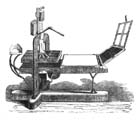La Pie Voleuse, The Narrative of the Magpie
Title Page Transcription:
La Pie Voleuse. | [single rule] | THE | NARRATIVE | OF | THE MAGPIE; | OR THE MAID OF PALAISEAU. | BEING THE HISTORY OF | THE MAID AND THE MAGPIE. | FOUNDED UPON THE CIRCUMSTANCE | Of an unfortunate female [gothic] | HAVING BEEN | UNJUSTLY SENTENCED TO DEATH, | ON STRONG | PRESUMPTIVE EVIDENCE. | [single rule] | WITH A PREFACE, | AND CURIOUS ANECDOTES. | [double rule] | The romantic Drama of the MAID AND THE MAGPIE has excited | the deepest and most extraordinary Interest, and is received with | UNANIMOUS AND REPEATED SHOUTS OF APPLAUSE. | [double rule] | [expert but simple graphic depicting a bird hanging in the gallows] | LONDON: | Printed by J. Swan, 76, Fleet Street, | FOR WILLIAM HONE, 55, FLEET-STREET. | 1815. | (PRICE SIXPENCE)
Contents:
The piece is an eighteen page, octavo pamphlet containing a prefatory "To the Reader" (A1-A2), the central text entitled "The Narrative of the Maid and the Magpie &c." (A3-B3), and finally a set of "Curious Anecdotes and Facts" (B4-B8).
Description:
"To the Reader"
The brief introduction first recounts the original tale and offers a brief background on the present popular play. (La Pie Voleuse was playing in a London theatre during the summer of 1815.) Hone acknowledges that the basic plot is very sketchy; indeed, "There is little to attach us to the victim of injustice beyond the fact of her oppression; but innocence suffering the punishment of the guilty seizes with firm grasp upon the feelings, and the combination of the attendant circumstances produce an effect truly astonishing [sic]" (iii-iv).
The preface mentions that the play had already been associated in the public mind with the Fenning case, and the editor claims that, in essence, he has simply taken the popular drama and recast it as a prose narrative. To further clarify the relationship between the drama and the prose narrative, he has placed in italics or all capitals the sentiments most loudly applauded by audiences.
The preface is signed M. E. [??]
"The Narrative"
The narrative itself is very simple. Annette, the well born servant girl, is accused of stealing a spoon and a fork from her masters, the good farmer Gerard and his wife, the suspicious Dame Gerard. The evidence against her--thanks to an outrageously unlikely series of plot events--is very damning indeed, but, at the last second, the pet magpie is discovered (by Blazeau, Annette's worthy lover) to have been the thief. Annette is freed from the gallows.
Especially noteworthy here is the role of the local Justice. He initially makes sexual advances toward Annette, but, when he is refused, he vows revenge upon her. It is at this moment that the case of the stolen silver comes before him, and he tries it with furious enthusiasm. For the Justice, the case becomes a scene of vengeance rather than a dispassionate search for truth. At the very end, when Annette is cleared by the chance discovery made by her beloved Blazeau, "Nothing remained for him [Justice] but--to hang the magpie" (13).
Stylistically the narrative is very crude, choppy, schematic. Devoid of any descriptive or dramatic development, it reads rather like an opera plot synopsis. (Rossinni, of course, actually wrote one on La Pie Voleuse.)
"Curious Anecdotes and Facts"
After the narrative proper, Hone inserts (pp. 14-18) accounts of peculiar cases in which people were wrongfully accused, tortured, even put to death on the strength of merely "circumstantial evidence." The connection to the Fenning case seems clear enough, though it is not explicitly set forth. One wonders, however, if the pieces might be included to help fulfill the requisite sheets. Most of the accounts are brief, one or two paragraph narratives
